Special Feature: Products Sally Recommends
Bar Fight
Technically, it’s not a real fight. But there’s plenty of action in the world of chocolate bars and candy bars today. Small-scale chocolatiers and chocolate manufacturers (as well as some of the big players) have decided that there’s money to be made in this realm, and they’re correct. A significant chunk of the American population is no longer content with the overly-sweet candy and chocolate bars of their youth. They want bars made with better ingredients, and, in many cases, confections that are less sweet.
As usual, I’ll begin by defining some terms. A chocolate bar is a bar that’s made of, well, chocolate. That can be white, milk, or dark chocolate (sometimes it’s a combination of types). Many chocolate bars these days contain “add-ins”; these range from cacao nibs to green tea extract to Goji berries to nuts. But the emphasis is (or should be) on the chocolate here. Chocolate bars are usually thin, compared to candy bars. A candy bar frequently contains chocolate, or is enrobed in it. But candy bars are often made of multiple components and/or constructed in multiple layers, and some of those layers are made from boiled sugar syrups (specifically, caramel and/or nougat). The Hershey bar I grew up eating as a kid is a chocolate bar. Candy bars include Baby Ruth, Three Musketeers, Snickers, and the like. See the difference?
Not so long ago, I wrote an article for this column called “The Mavericks of American Chocolate”, which highlighted manufacturers of bean-to-bar chocolates in the US. I included most of the small-scale bean-to-bar makers I could find, and I called them “mavericks” because making bean-to-bar chocolate was not common in the US. Since then, making bean-to-bar has become positively trendy. More and more companies are jumping on this bandwagon; some are even making bean-to-bar-to-bonbon chocolates. It’s time-consuming, labor-intensive, and expensive to make your own chocolate. You need specialized equipment, and space for that equipment. And it can be a royal pain. Still, I understand why people do it. If you’re a culinary control freak (and if you’re going to have a small business dealing in chocolate these days, that’s almost mandatory), you can produce chocolate to precisely the standards you want, for any application you wish. You control the chocolate’s flavor, texture, viscosity, and multiple other characteristics, so you’ll be able to consistently produce a specific chocolate for a bar to your exact tastes or for an edible chocolate sculpture or for your best pistachio bonbon. In addition, producing your own chocolate still bestows a certain prestige, a degree of elevation; not everyone will take the time or trouble to make chocolate. Unquestionably, consumers will pay more for these products, but many people find them far superior to more conventionally-produced bars. In the case of small-scale manufacturers, chocolate bars made in this way are typically created from single-origin beans. And I’ve found that many bean-to-bar makers manufacture primarily, if not exclusively, dark chocolate, a boon for vegans and those who cannot consume dairy products.
In contrast with the many who are signing up to make bean-to-bar chocolate, it is far less common to find small-scale businesses that manufacture candy bars, although that’s slowly starting to change. I’m not sure why this is true; I can’t believe that making candy bars would be more difficult than making chocolate (chocolate is a depressingly persnickety material to work with). And given that some people are willing to pay more for less-sweet chocolate made with superior ingredients, surely the same would be true for better-quality candy bars? At any rate, I have found several businesses who make candy bars, though again, I’m sure it’s not a complete list. I especially like the creativity I see from these sources. Bars are layered with caramel (and I mean good caramel that obviously took time and effort to produce) and/or different flavors of nougat. The ingredients are fresh; these bars don’t sit in warehouses for weeks or months before you consume them. These are bars that deserve a few minutes out of your busy day; they’re bars to savor and, perhaps, to share (if you know someone who’s been very, very good lately).
Once in a blue moon, you’ll find what I call a “Crossover Bar”, one that blurs the line between chocolate bar and candy bar. Xocolatl de David has two such bars at this writing, a Salted Caramel Bar and a Bacon Caramel Bar. Both are chocolate bars, with tiny chunks of the appropriate caramel distributed within their chocolate framework.
Whether you decide to try chocolate bars or candy bars from any of these businesses, plan on giving them sufficient time to work! While some of the “larger” companies here have a handful or so of employees, some are one or two person outfits. They don’t keep large inventories on hand, and chocolate and candy bars made with such care cannot suddenly come into being with the wave of a wand. I’m not a patient person, as a rule, but here patience really is a virtue, and you’ll be rewarded for your wait. If you need these products by a certain date, ask if the manufacturer can have them to you before you order. And order early for any holidays, particularly the December holidays. I hope you’ll make a point to try a chocolate or candy bar from at least one manufacturer below; I think you’ll find there’s quite a difference from any of the bars you had in your youth.
More Small-Scale Bean-to-Bar (or Bean-to-Bar-to-Bonbon) Chocolate Makers:
Please note that I haven’t tried any of these products; in fact, I hadn’t even heard of a number of these companies before I started research for this article, and I know this is an incomplete list. As usual, your taste buds should be your only guide in determining any favorites here. Producers are listed in alphabetical order.
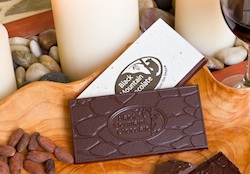 ---Black Mountain Chocolate, www.blackmountainchocolate.com. David Mason was once in golf course management. Now, he makes bean-to-bar chocolate in both 55% and 70% cacao percentages, with a couple of variations on each theme. Also offered: a savory Nib Rub, a goats’ milk soap with cocoa shells, and more.
---Black Mountain Chocolate, www.blackmountainchocolate.com. David Mason was once in golf course management. Now, he makes bean-to-bar chocolate in both 55% and 70% cacao percentages, with a couple of variations on each theme. Also offered: a savory Nib Rub, a goats’ milk soap with cocoa shells, and more.
---Cacao Atlanta, www.cacaoatlanta.com. Kristen Hard works her culinary magic on beautifully-packaged “Love Bars” (as they’re called), all made with her 75% chocolate. The Fruit & Nut Barks, Truffles, and Chocolate Salami (yes, you read that correctly) are also created with her bean-to-bar chocolate.
---Escazu Artisan Chocolates, www.escazuchocolates.com. “Bean-to-bar-to-confection” chocolates are made here. The bars include offerings with sea salt, cacao nibs, and chiles.
---French Broad Chocolates, http://frenchbroadchocolates.com. Dan and Jael Rattigan produce a variety of intriguing confections and are just on the verge of diving headfirst into bean-to-bar production. Look for those offerings from them no later than spring of 2012.
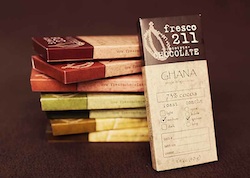 ---Fresco Chocolate, http://frescochocolate.com. Fresco seems to be about educating people as much as they are about offering different chocolate bars (see their notes on roasting and conching levels, as well as the bean-to-bar video). Fantastic packaging! Currently available only via select retail outlets.
---Fresco Chocolate, http://frescochocolate.com. Fresco seems to be about educating people as much as they are about offering different chocolate bars (see their notes on roasting and conching levels, as well as the bean-to-bar video). Fantastic packaging! Currently available only via select retail outlets.
 ---Lillie Belle Farms, www.lilliebellefarms.com. After two years of sourcing beans and swearing at equipment that didn’t quite get the job done, Jeff Shepherd has recently introduced three examples of bean-to-bar chocolate. He notes that he really likes the bean-to-bar gig, so expect more bars (and confections?) of this type from Lillie Belle in the future. His Purple Haze is to the right.
---Lillie Belle Farms, www.lilliebellefarms.com. After two years of sourcing beans and swearing at equipment that didn’t quite get the job done, Jeff Shepherd has recently introduced three examples of bean-to-bar chocolate. He notes that he really likes the bean-to-bar gig, so expect more bars (and confections?) of this type from Lillie Belle in the future. His Purple Haze is to the right.
---Mindo Chocolate Makers, http://mindochocolate.com. “From harvest to bar” is the slogan here; Mindo begins their laborious process by buying organic cacao beans from farmers who are members of an organic, fair trade cooperative. Products available include everything from raw cacao beans to chunks of chocolate designed for baking to tasting disks (small, flat rounds of chocolate
; you can special-order these to include dried fruit, nibs, sea salt, nuts, or espresso).
---Potomac Chocolate, www.potomacchocolate.com. The first bean-to-bar maker in the Washington, D.C. area. At this writing, three different bars are offered; note that this is a new business, so there’ll likely be more in the future.
---Ritual Chocolate, www.ritualchocolate.com. As I write this, this Colorado-based company has exactly one bar on offer, but they are just getting started in the world of retail chocolate. Bars are/will be organic and direct-trade.
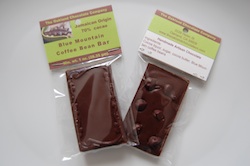 ---The Oakland Chocolate Company, http://theoaklandchocolateco.com. Bean-to-bar-to-bonbon chocolates made exclusively from beans grown in one parish of Jamaica. A lovely selection of individual bonbons.
---The Oakland Chocolate Company, http://theoaklandchocolateco.com. Bean-to-bar-to-bonbon chocolates made exclusively from beans grown in one parish of Jamaica. A lovely selection of individual bonbons.
Small-Scale Candy Bar Makers
Again, these are listed in alphabetical order.
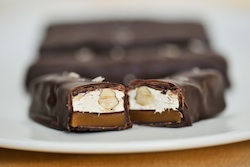 ---Bees & Beans, http://beesandbeans.com. Faith Dionne has a modest but luscious-looking list of candy bars, emphasizing ingredients she can find locally (in Oregon). These include honey, butter, berries, walnuts, and the state’s beloved filberts, also known as hazelnuts. Check out the Coffee Bar, with a coffee caramel (one of my favorite flavor combinations!) and toasted walnuts, hand-dipped in a 70% chocolate.
---Bees & Beans, http://beesandbeans.com. Faith Dionne has a modest but luscious-looking list of candy bars, emphasizing ingredients she can find locally (in Oregon). These include honey, butter, berries, walnuts, and the state’s beloved filberts, also known as hazelnuts. Check out the Coffee Bar, with a coffee caramel (one of my favorite flavor combinations!) and toasted walnuts, hand-dipped in a 70% chocolate.
---Didi’s Chocolates, http://didischocolates.com. You can choose your bars in any assortment you order here, but the choice won’t be easy! Coconut Crush, Triple Caramel, and Hazelnut Gianduja are three of the tempting varieties offered.
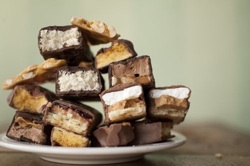 ---Liddabit Sweets, www.liddabitsweets.com. The candy bars here are playful, with spins on both childhood classics (the PB&J) and old favorites (The Snacker and the S’More). There’s even a nod to Elvis (“The King”). I particularly like the seasonal bars, an idea I haven’t seen in many other places.
---Liddabit Sweets, www.liddabitsweets.com. The candy bars here are playful, with spins on both childhood classics (the PB&J) and old favorites (The Snacker and the S’More). There’s even a nod to Elvis (“The King”). I particularly like the seasonal bars, an idea I haven’t seen in many other places.
---Xocolatl de David, www.xocolatldedavid.com. An elegant Raleigh Bar (a layer of salted caramel atop a honey pecan chocolate nougat, all enrobed in chocolate) and a bacon option are on offer here. You’ll also find chocolate bars (not bean-to-bar) with touches you don’t see every day, such as a chile-fleur du sel-crispy pig skin mixture, and “crossover” bars, those with tiny chunks of caramel scattered inside.
![]()
Stephanie (HandOverTheChocolate@comcast.net) has had a strong affinity for chocolate from a very early age. Family members claim that, as a child, she was able to hear chocolate being opened in the kitchen no matter where she was in the house. Stephanie was baking by the time she was 6 and ran a short-lived baking business out of her parents’ kitchen when she was in high school. She has a Master’s Degree in Foods from Virginia Tech but no formal training in cooking or baking. Consequently, she is a home cook, not a chef. Prior to beginning this column, she had written about chocolate for some 8 years.
Note: This information was accurate when it was published. Please be sure to confirm all rates and details directly with the businesses in question before making your plans.



